Enhanced Blast Response Simulation of LG Panels Using an Elasto-Damage Model with the Finite Element Method
Abstract
:1. Introduction
2. Experimental Work
2.1. Material Characterization
2.2. Shock Tube Testing
3. Numerical Modeling
4. Experimental Results and Discussion
4.1. Material Characterization Results
4.2. Shock Tube Testing Results
5. Numerical Results
5.1. Validation of Numerical Model
5.2. Parametric Study on Effect of Glass Type
6. Conclusions
Author Contributions
Funding
Data Availability Statement
Conflicts of Interest
References
- Norville, H.S.; Harvill, N.; Conrath, E.J.; Shariat, S.; Mallonee, S. Glass-Related Injuries in Oklahoma City Bombing. J. Perform. Constr. Facil. 1999, 13, 50–56. [Google Scholar] [CrossRef]
- Martín, M.; Centelles, X.; Solé, A.; Barreneche, C.; Fernández, A.I.; Cabeza, L.F. Polymeric interlayer materials for laminated glass: A review. Constr. Build. Mater. 2020, 230, 116897. [Google Scholar] [CrossRef]
- Nawar, M.; Salim, H.; Newberry, M.; El-Sisi, A. High strain rate response of laminated glass interlayer materials. Constr. Build. Mater. 2021, 299, 123934. [Google Scholar] [CrossRef]
- El-Sisi, A.; Newberry, M.; Knight, J.; Salim, H. Nawar, Static and high strain rate behavior of aged virgin PVB. J. Polym. Res. 2022, 29, 39. [Google Scholar] [CrossRef]
- Elbelbisi, A.; El-Sisi, A.; Knight, J.; Philipps, J.C.; Newberry, M.; Salim, H. Influence of panels size on the static and dynamic performance of laminated glass panels. Constr. Build. Mater. 2023, 399, 132562. [Google Scholar] [CrossRef]
- Shetty, M.S.; Wei, J.; Dharani, L.R.; Stutts, D.S. Analysis of Damage in Laminated Architectural Glazing Subjected to Wind Loading and Windborne Debris Impact. Buildings 2013, 3, 422–441. [Google Scholar] [CrossRef]
- Nawar, M.; Salim, H.; Lusk, B.; Kiger, S. Numerical Simulation and Verification of Curtain Wall Systems under Shock Pressure. Pract. Period. Struct. Des. Constr. 2014, 19, 04014008. [Google Scholar] [CrossRef]
- Nawar, M.; Salim, H.; Lusk, B.; Perry, K.; Kiger, S.; Miller, G. Modeling and testing of laminated curtain wall systems under blast loading. In Proceedings of the Structures Congress 2013: Bridging Your Passion with Your Profession-Proceedings of the 2013 Structures Congress, Pittsburgh, PA, USA, 2–4 May 2013; pp. 170–180. [Google Scholar] [CrossRef]
- Bedon, C.; Noè, S.; Fasan, M.; Amadio, C. Role of In-Field Experimental Diagnostic Analysis for the Derivation of Residual Capacity Indexes in Existing Pedestrian Glass Systems. Buildings 2023, 13, 754. [Google Scholar] [CrossRef]
- Amadio, C.; Bedon, C. Blast Analysis of Laminated Glass Curtain Walls Equipped by Viscoelastic Dissipative Devices. Buildings 2012, 2, 359–383. [Google Scholar] [CrossRef]
- Biolzi, L.; Simoncelli, M. Overall response of 2-ply laminated glass plates under out-of-plane loading. Eng. Struct. 2022, 256, 113967. [Google Scholar] [CrossRef]
- Chen, X.; Chen, S.; Zhang, Y.; Wang, Z. Blast Resistance of Ionomer-Laminated Glass and the Effect of Negative Blast Pressure. J. Struct. Eng. 2023, 149, 4022221. [Google Scholar] [CrossRef]
- Xia, W.; Yue, Z.; Zang, M. Impact Fracture Simulation of Laminated Glass Based on Thick Shell Elements and a Cohesive Zone Model. Materials 2023, 16, 6966. [Google Scholar] [CrossRef]
- Liu, W.; Shi, Y.; Hao, H.; Cui, J. Experimental and numerical study on dynamic behavior of laminated glass window under combustible gas explosions. Eng. Struct. 2024, 300, 117159. [Google Scholar] [CrossRef]
- El-Belbisi, A. Strengthening of Pre-stressed Steel--Concrete Composite Beams Using Carbon Fiber Tendons—A Parametric Study. Arch. Med. 2018, 4, 7. [Google Scholar]
- Knight, J.T.; El-Sisi, A.A.; Elbelbisi, A.H.; Newberry, M.; Salim, H.A. Mechanical Behavior of Laminated Glass Polymer Interlayer Subjected to Environmental Effects. Polymers 2022, 14, 5113. [Google Scholar] [CrossRef]
- Eslami, M.; Mosalam, K.M.; Kodur, V.; Young, C.C. Multi-performance blast pressure-duration curves for point-supported laminated and monolithic glass panes. Eng. Struct. 2023, 293, 116620. [Google Scholar] [CrossRef]
- Ahani, A.; Ahani, E. An overview for materials and design methods used for enhancement of laminated glass. Hybrid Adv. 2023, 3, 100063. [Google Scholar] [CrossRef]
- CBedon; Larcher, M.; Bez, A.; Amadio, C. Numerical Analysis of TGU Windows under Blast–GLASS-SHARD Outlook. In Proceedings of the Challenging Glass Conference Proceedings, Ghent, Belgium, 8–24 June 2022; Volume 8. [Google Scholar]
- Norville, H.S.; Conrath, E.J. Blast-Resistant Glazing Design. J. Archit. Eng. 2006, 12, 129–136. [Google Scholar] [CrossRef]
- Norville, H.S.; Conrath, E.J. Considerations for Blast-Resistant Glazing Design. J. Archit. Eng. 2001, 7, 80–86. [Google Scholar] [CrossRef]
- Biggs, J.M. Introduction to Structural Dynamics; McGraw-Hill Companies: New York, NY, USA, 1964. [Google Scholar]
- Krauthammer, T.; Altenberg, A. Negative phase blast effects on glass panels. Int. J. Impact Eng. 2000, 24, 1–17. [Google Scholar] [CrossRef]
- Wei, J.; Dharani, L.R. Response of laminated architectural glazing subjected to blast loading. Int. J. Impact Eng. 2006, 32, 2032–2047. [Google Scholar] [CrossRef]
- Morison, C. The Resistance of Laminated Glass to Blast Pressure Loading and the Coefficients for Single Degree of Freedom Analysis of laminated Glass. Ph.D. Thesis, Cranfield University, Cranfield, UK, 2007. [Google Scholar]
- Hidallana-Gamage, H.D.; Thambiratnam, D.P.; Perera, N.J. Failure analysis of laminated glass panels subjected to blast loads. Eng. Fail. Anal. 2014, 36, 14–29. [Google Scholar] [CrossRef]
- Meyers, G.E.; Baldwin, D.; Mlakar, P. State of the Art of Blast Resistant Windows; Defense Technical Information Centre (DTIC): Fort Belvoir, VA, USA, 1994; p. 25. [Google Scholar]
- Weissman, S.; Dobbs, N.; Stea, W.; Price, P. Blast Capacity Evaluation of Glass Windows and Aluminum Window Frames; Ammann and Whitney: New York, NY, USA, 1978. [Google Scholar]
- Ge, J.; Li, G.-Q.; Chen, S.-W. Theoretical and experimental investigation on fragment behavior of architectural glass panel under blast loading. Eng. Fail. Anal. 2012, 26, 293–303. [Google Scholar] [CrossRef]
- Larcher, M.; Solomos, G.; Casadei, F.; Gebbeken, N. Experimental and numerical investigations of laminated glass subjected to blast loading. Int. J. Impact Eng. 2012, 39, 42–50. [Google Scholar] [CrossRef]
- Hooper, P. Blast Performance of Silicone-Bonded Laminated Glass; Department of Mechanical Engineering: London, UK, 2011; p. 304. [Google Scholar]
- Zhang, X.; Hao, H. Experimental and numerical study of boundary and anchorage effect on laminated glass windows under blast loading. Eng. Struct. 2015, 90, 96–116. [Google Scholar] [CrossRef]
- Zhang, X.; Hao, H.; Wang, Z. Experimental study of laminated glass window responses under impulsive and blast loading. Int. J. Impact Eng. 2015, 78, 1–19. [Google Scholar] [CrossRef]
- Bedon, C.; Zhang, X.; Santos, F.; Honfi, D.; Kozłowski, M.; Arrigoni, M.; Figuli, L.; Lange, D. Performance of structural glass facades under extreme loads—Design methods, existing research, current issues and trends. Constr. Build. Mater. 2018, 163, 921–937. [Google Scholar] [CrossRef]
- Momeni, M.; Bedon, C. Review on Glass Curtain Walls under Different Dynamic Mechanical Loads: Regulations, Experimental Methods and Numerical Tools. In Facade Design—Challenges and Future Perspective; Bedon, C., Kozlowski, M., Stepinac, M., Eds.; IntechOpen: Rijeka, Croatia, 2023. [Google Scholar] [CrossRef]
- Elbelbisi, A.H.; El-Sisi, A.A.; Hassan, H.A.; Salim, H.A.; Shabaan, H.F. Parametric Study on Steel–Concrete Composite Beams Strengthened with Post-Tensioned CFRP Tendons. Sustainability 2022, 14, 15792. [Google Scholar] [CrossRef]
- Del Linz, P.; Hooper, P.A.; Arora, H.; Smith, D.; Pascoe, L.; Cormie, D.; Blackman, B.R.K.; Dear, J.P. Reaction forces of laminated glass windows subject to blast loads. Compos. Struct. 2015, 131, 193–206. [Google Scholar] [CrossRef]
- Zhang, X.; Hao, H. The response of glass window systems to blast loadings: An overview. Int. J. Prot. Struct. 2016, 7, 123–154. [Google Scholar] [CrossRef]
- El-Sisi, A.; Bowman, A.; Elbelbisi, A.; Elkilani, A.; Robert, S.; Salim, H.; Nawar, M. Performance of LG window systems with different materials under extreme static loading. Constr. Build. Mater. 2023, 409, 133923. [Google Scholar] [CrossRef]
- Idriss, J.S.; Lowak, M.J. Empirical Evaluation of Glazing Systems in Response to Blast Loads. In Structures Congress; American Society of Civil Engineers: Reston, VA, USA, 2014; pp. 258–269. [Google Scholar] [CrossRef]
- ASTM D638-10; Standard Test Method for Tensile Properties of Plastics. Annual Book of ASTM Standards. ASTM International: West Conshohocken, PA, USA, 2010.
- Xu, J.; Li, Y.; Liu, B.; Zhu, M.; Ge, D. Experimental study on mechanical behavior of PVB laminated glass under quasi-static and dynamic loadings. Compos. B Eng. 2011, 42, 302–308. [Google Scholar] [CrossRef]
- Timmel, M.; Kolling, S.; Osterrieder, P.; Du Bois, P.A. A finite element model for impact simulation with laminated glass. Int. J. Impact Eng. 2007, 34, 1465–1478. [Google Scholar] [CrossRef]
- Pyttel, T.; Liebertz, H.; Cai, J. Failure criterion for laminated glass under impact loading and its application in finite element simulation. Int. J. Impact Eng. 2011, 38, 252–263. [Google Scholar] [CrossRef]
- Peng, Y.; Yang, J.; Deck, C.; Willinger, R. Finite element modeling of crash test behavior for windshield laminated glass. Int. J. Impact Eng. 2013, 57, 27–35. [Google Scholar] [CrossRef]
- Elbelbisi, A.; El-Sisi, A.; Mahmoud, M.E.; Newberry, M.; Salim, H. Influence of interlayer types and thicknesses on the blast performance of laminated glass panels. Structures 2023, 57, 105231. [Google Scholar] [CrossRef]
- Bedon, C.; Santi, M.V. Vulnerability and Structural Capacity Assessment of Historic Glass Facades under Bird-Strike. Math. Probl. Eng. 2022, 2022, 6059466. [Google Scholar] [CrossRef]
- Chen, Z.; Schreyer, H.L. Formulation and Computational Aspects of Plasticity and Damage Models with Application to Quasi-Brittle Materials; Sandia National Laboratories (SNL-NM): Albuquerque, NM, USA, 1995. [Google Scholar]
- Hooper, P.A.; Sukhram, R.A.M.; Blackman, B.R.K.; Dear, J.P. On the blast resistance of laminated glass. Int. J. Solids Struct. 2012, 49, 899–918. [Google Scholar] [CrossRef]
- Nawar, M.; Salim, H.; Lusk, B.; Kiger, S. Modeling and shock tube testing of architectural glazing systems for blast resistance. J. Struct. Eng. 2015, 141, 04014174. [Google Scholar] [CrossRef]
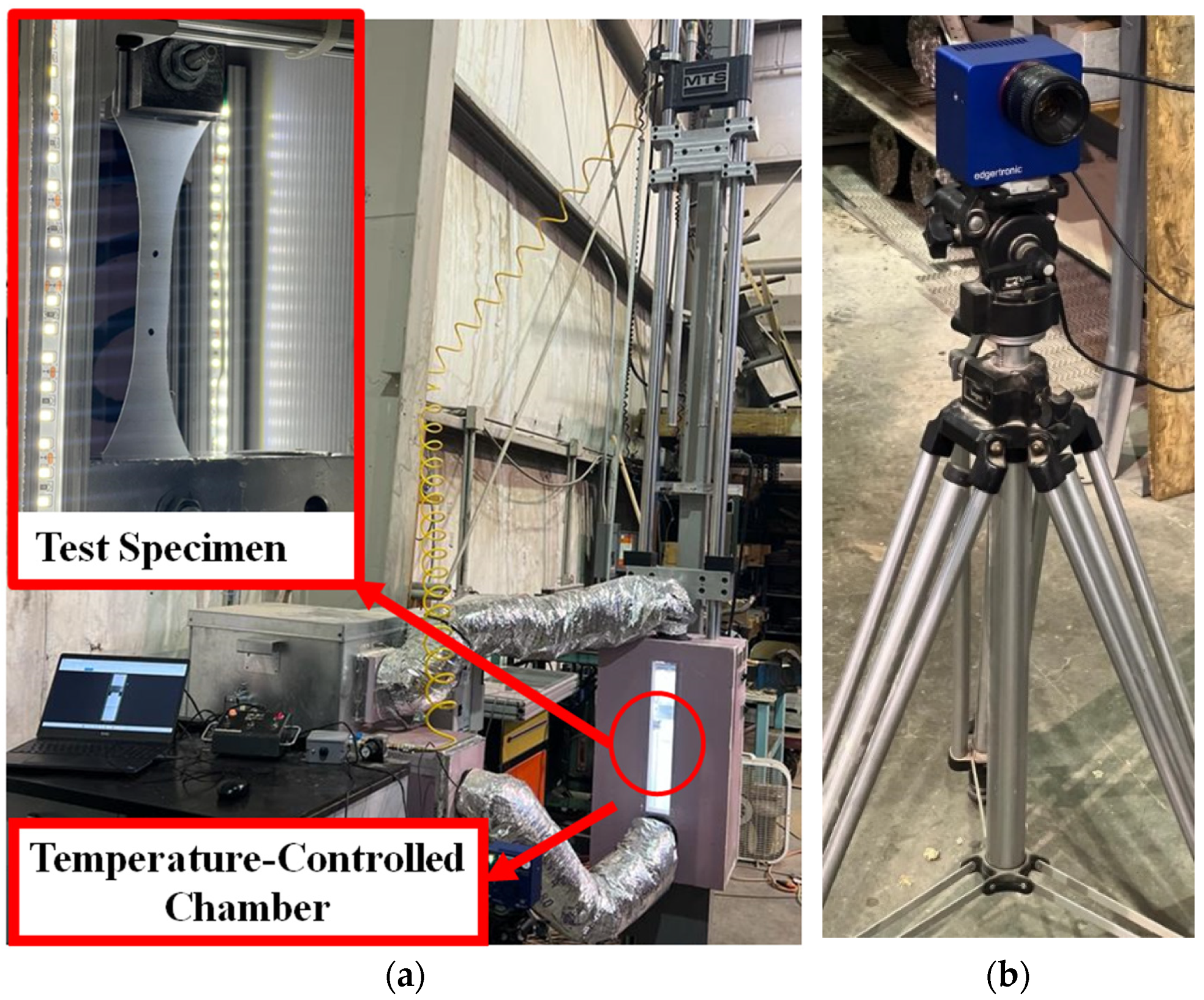
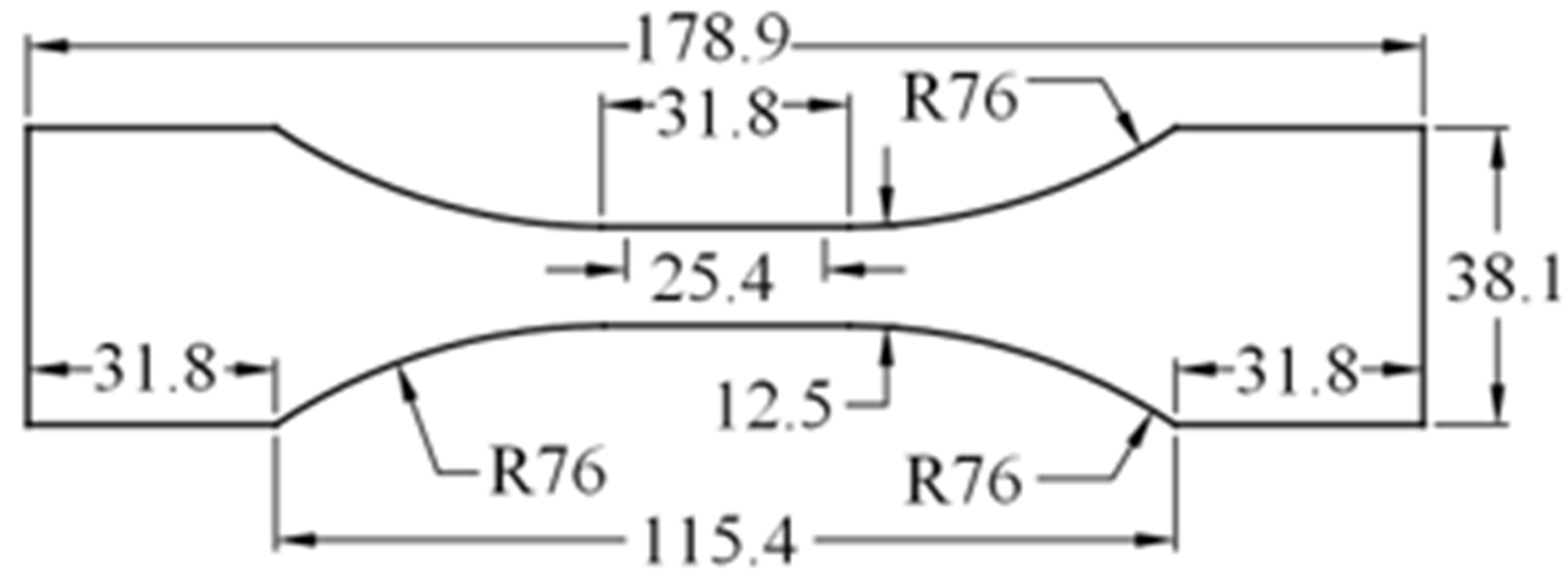
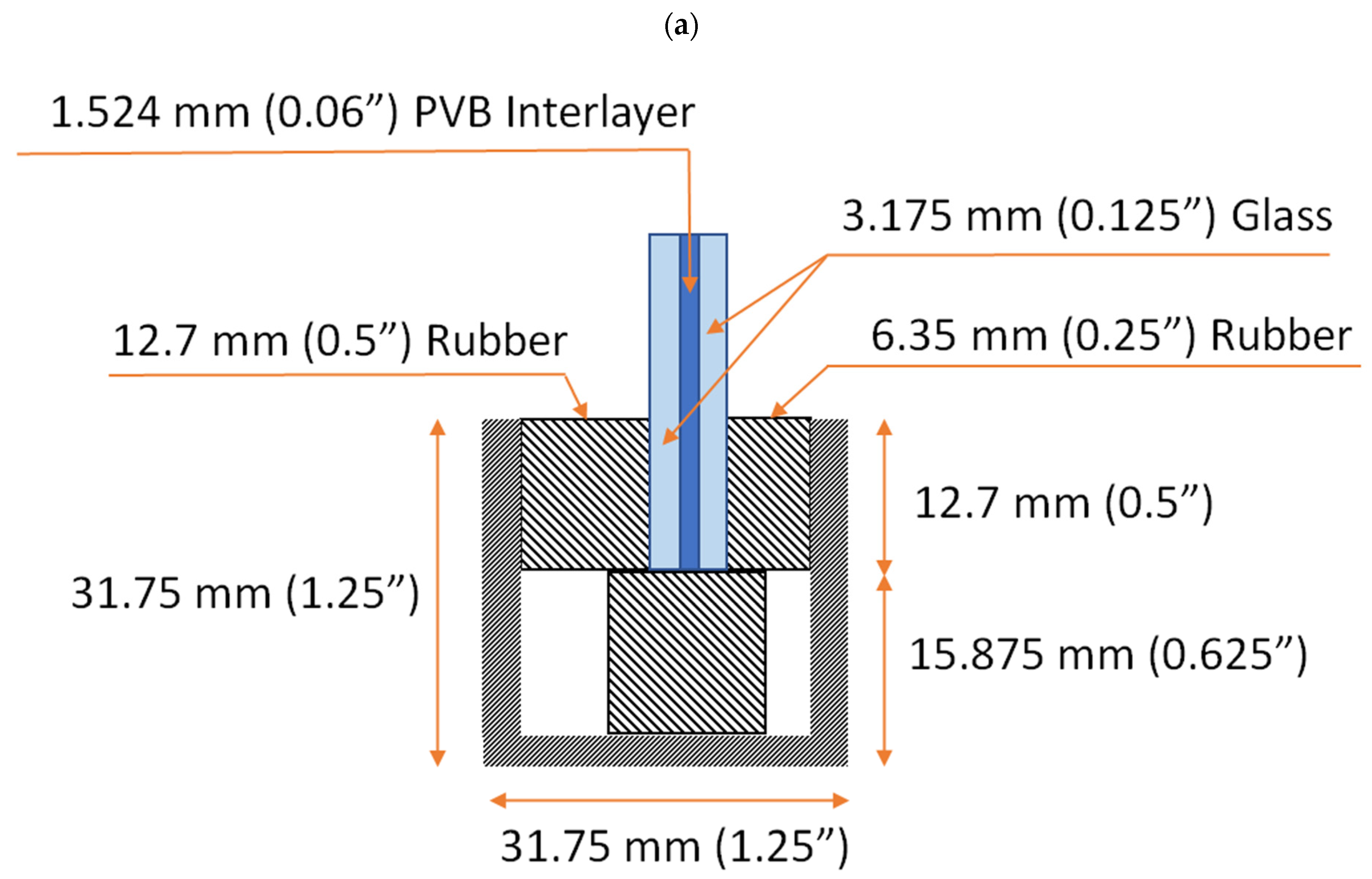
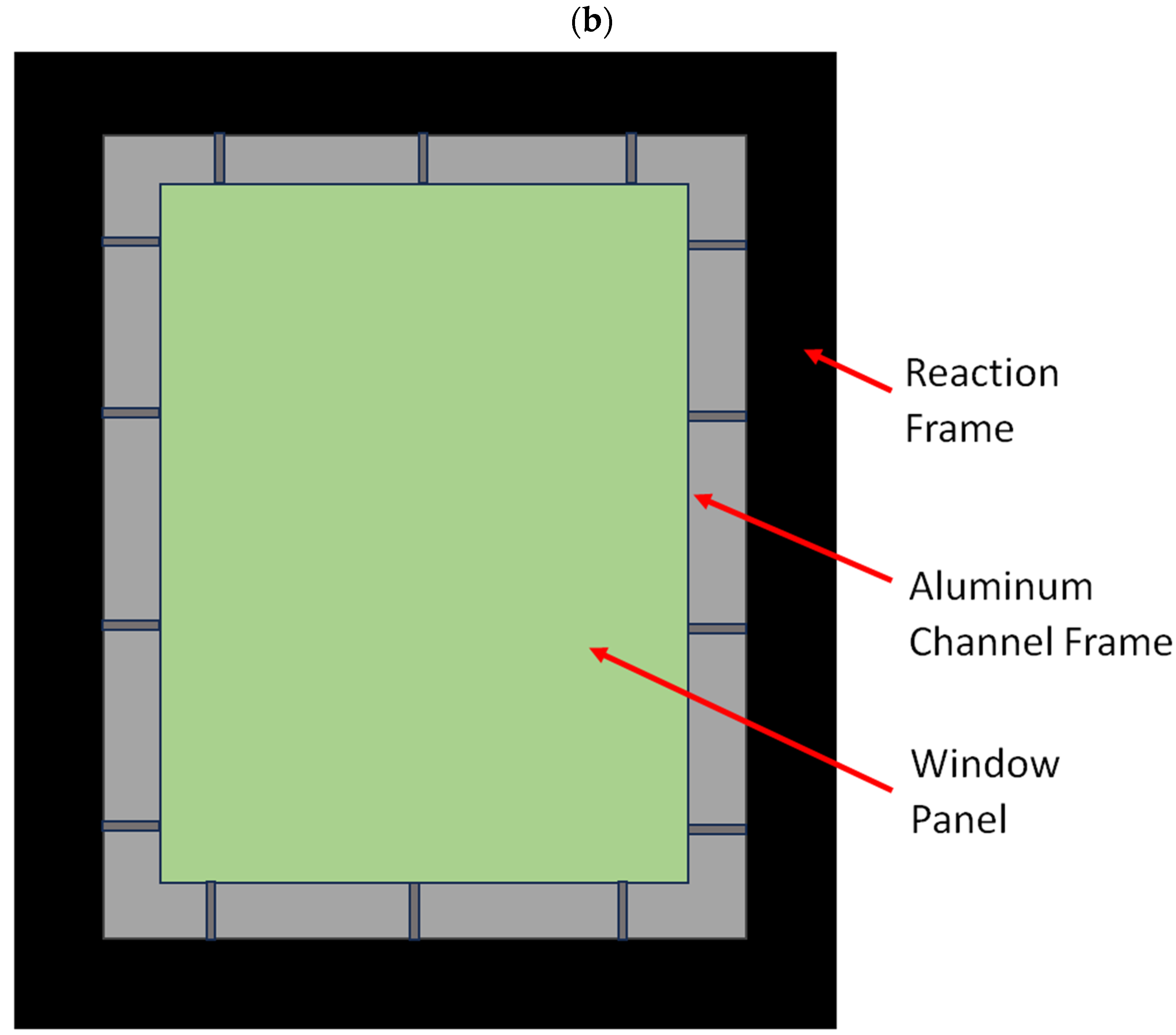
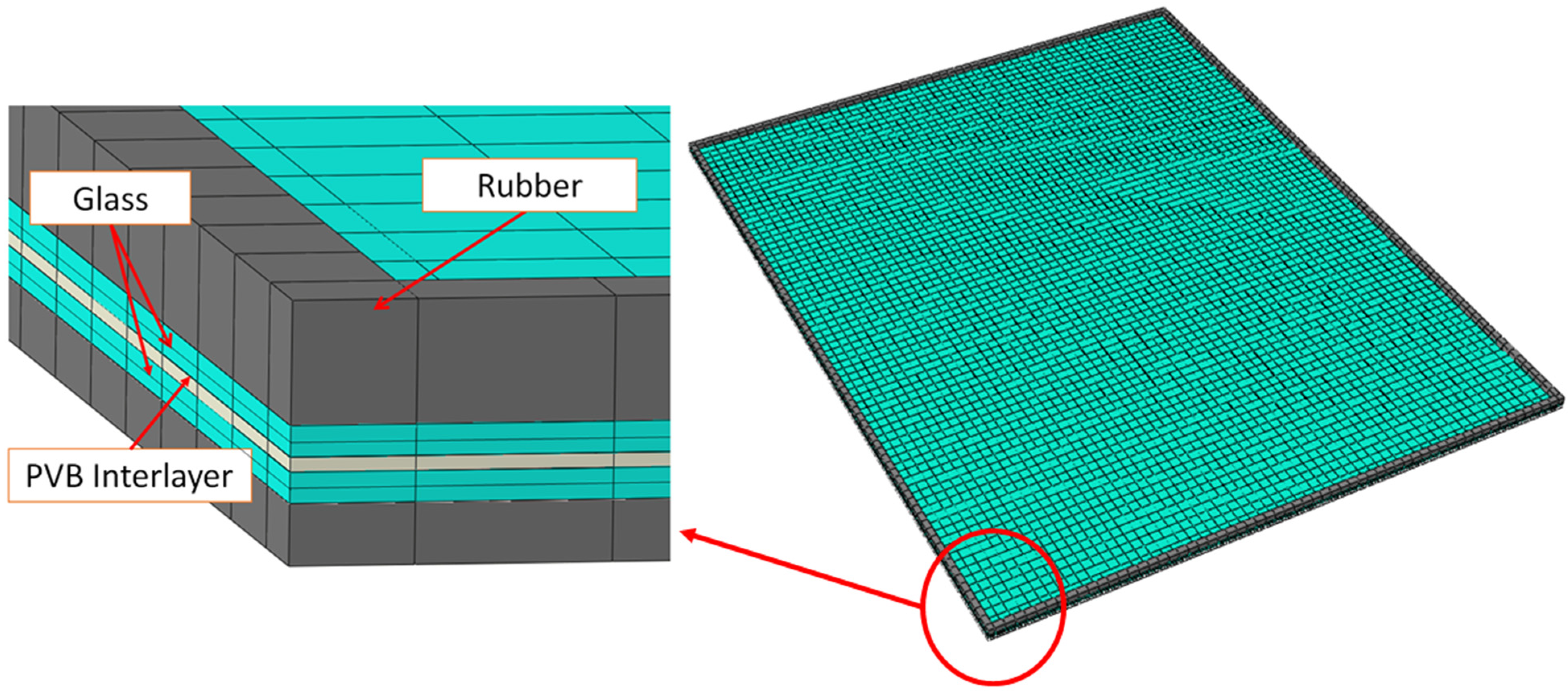
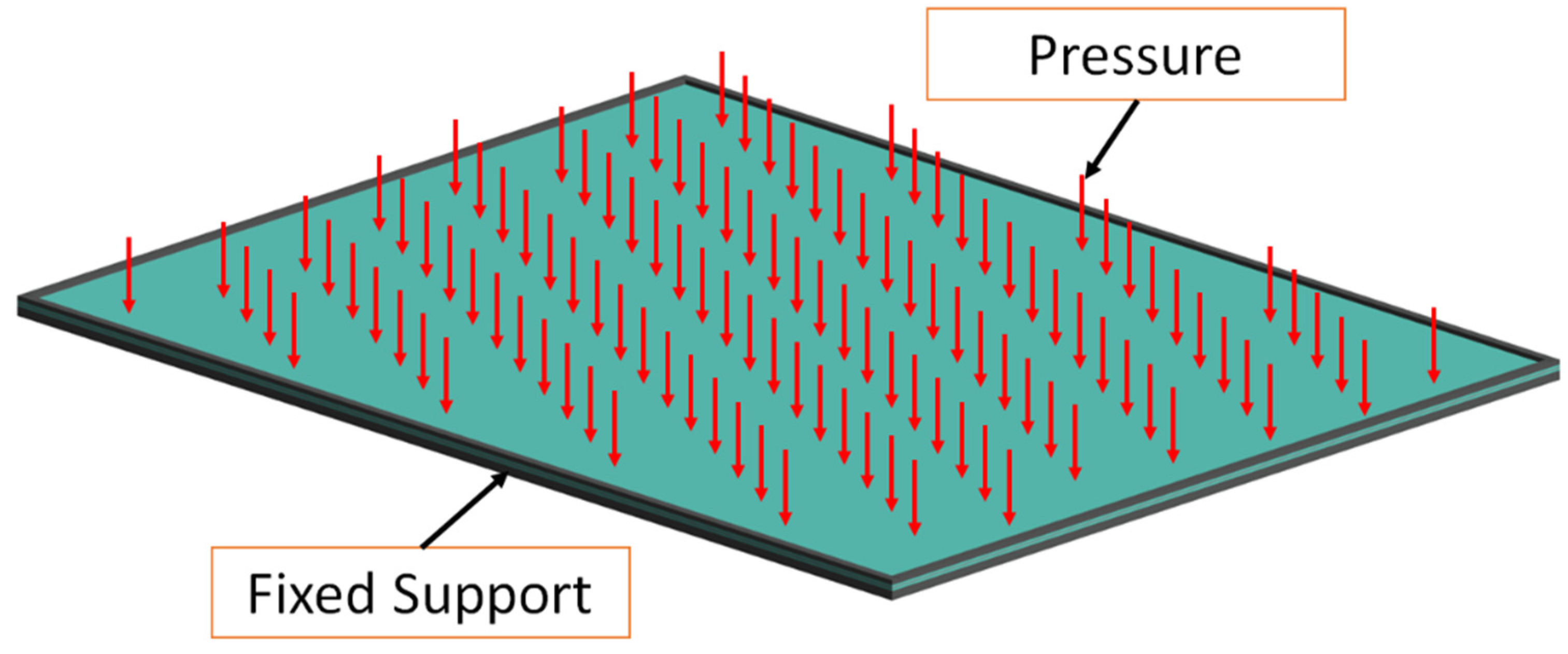
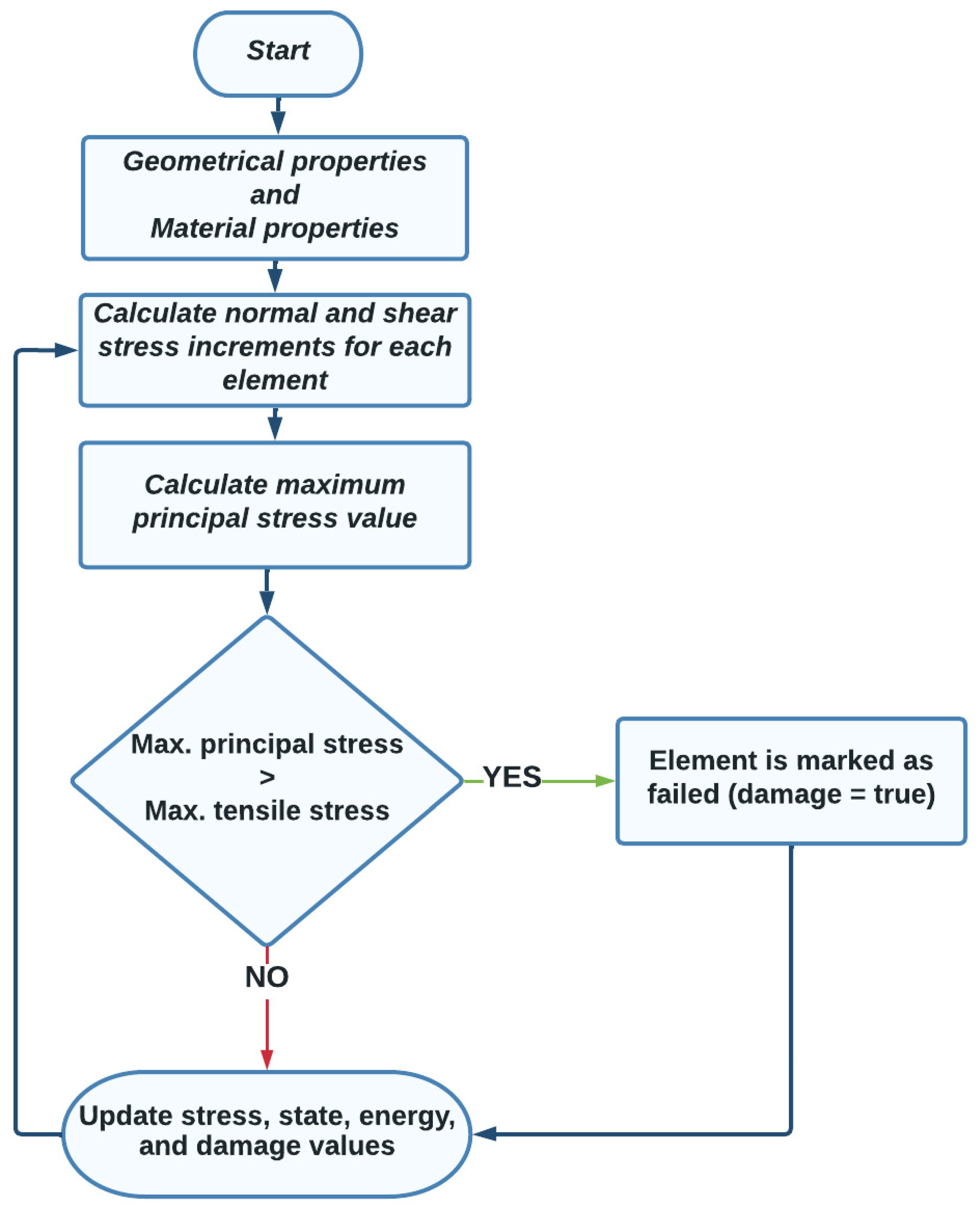
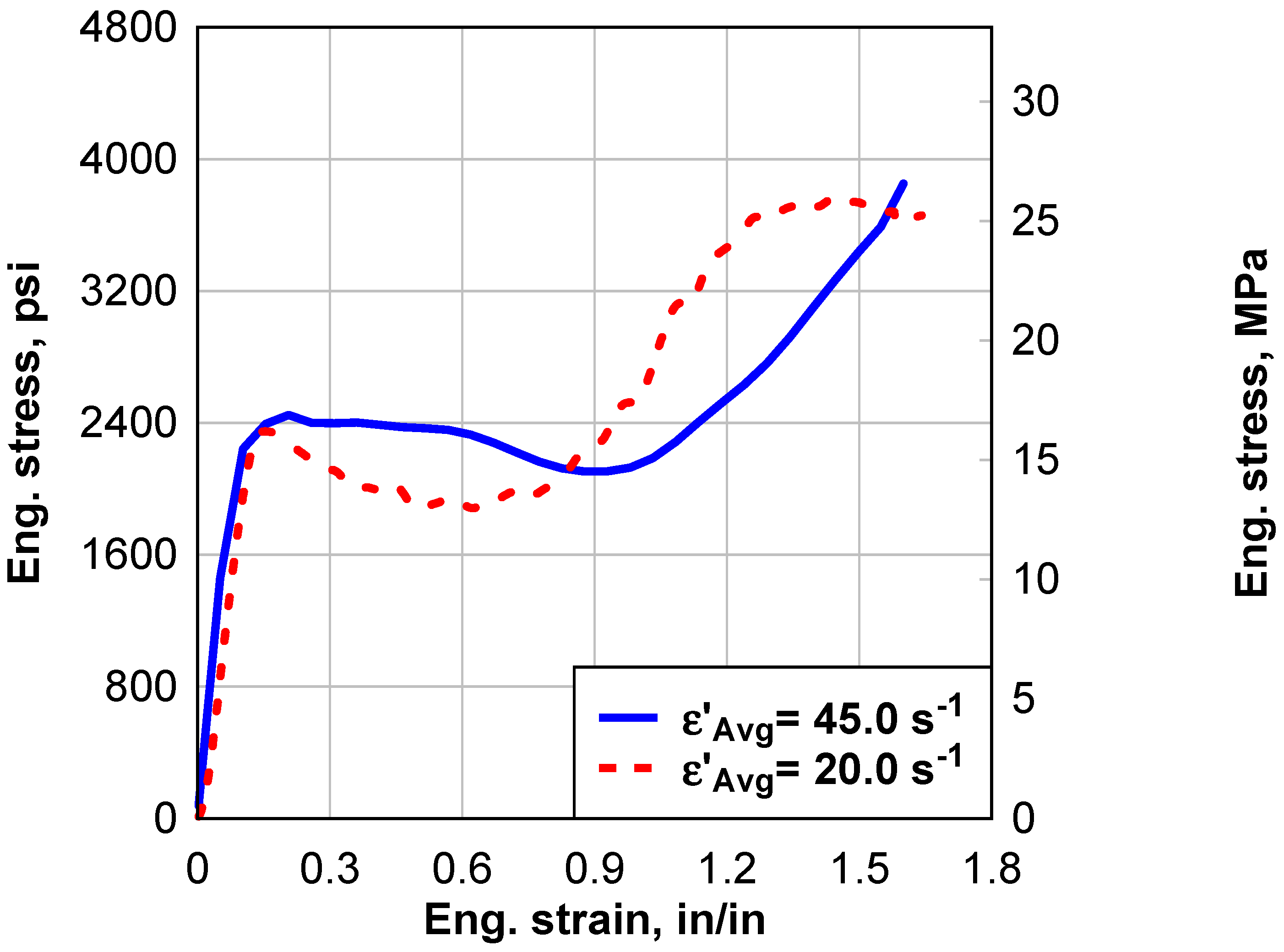
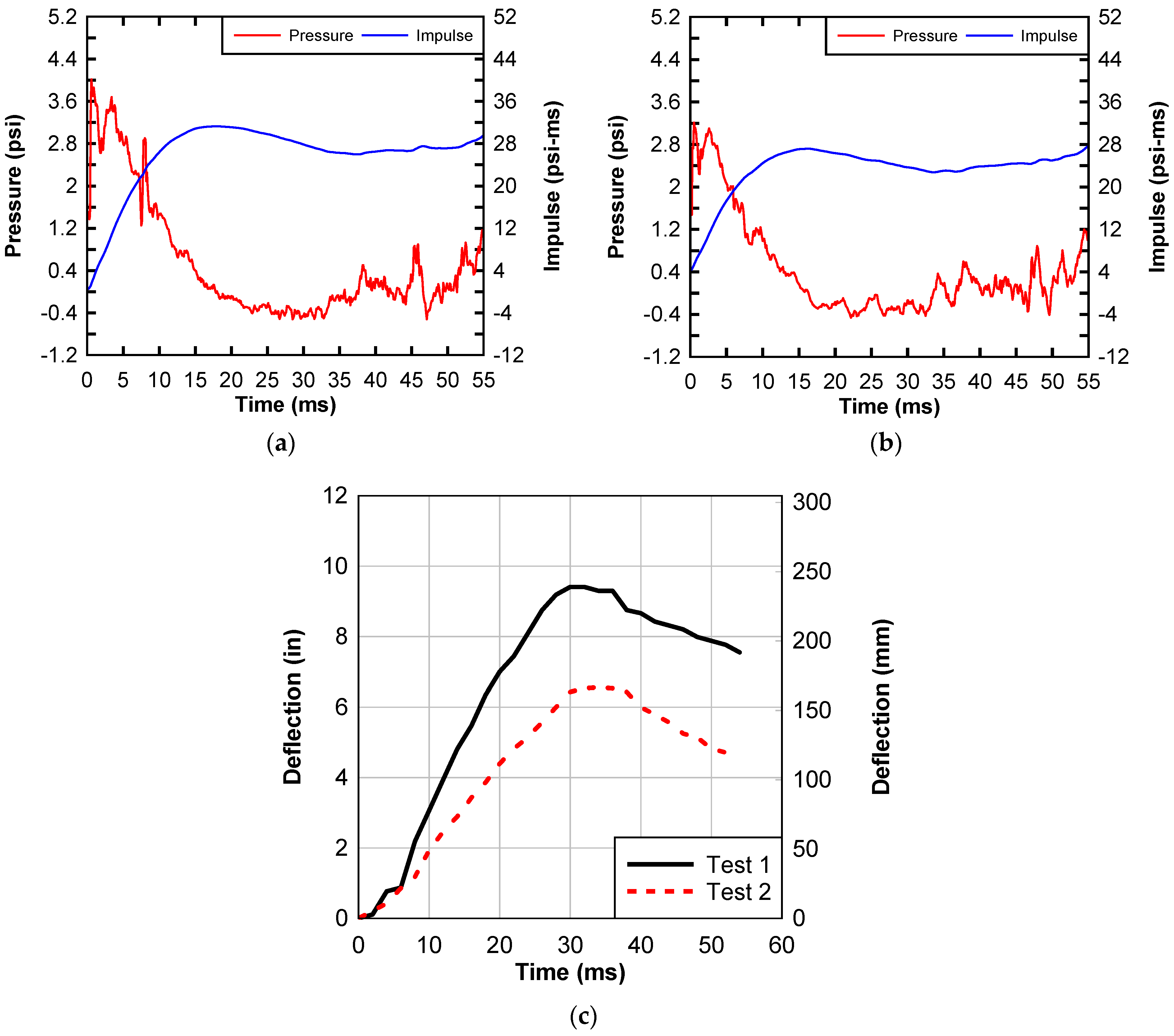
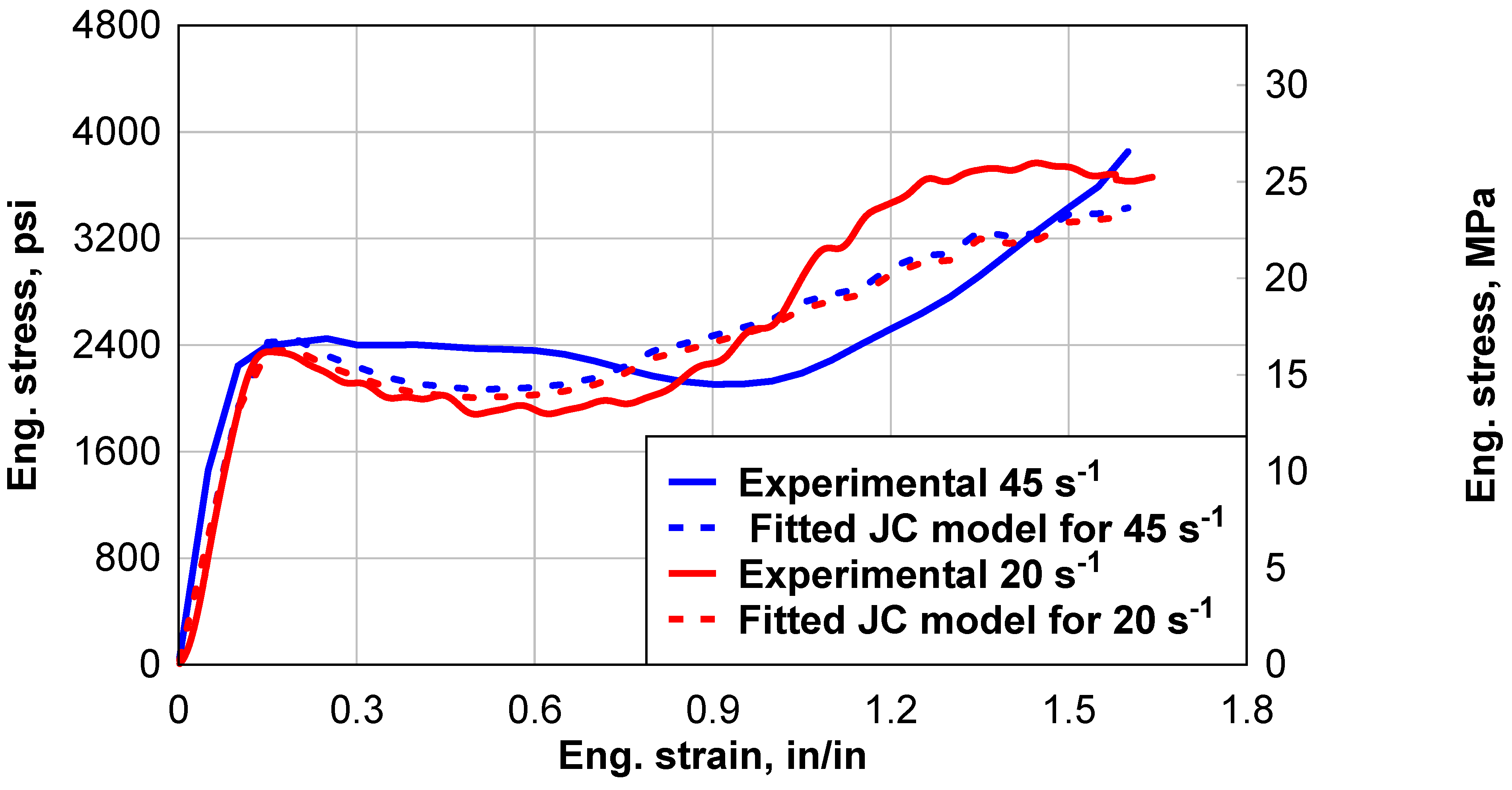
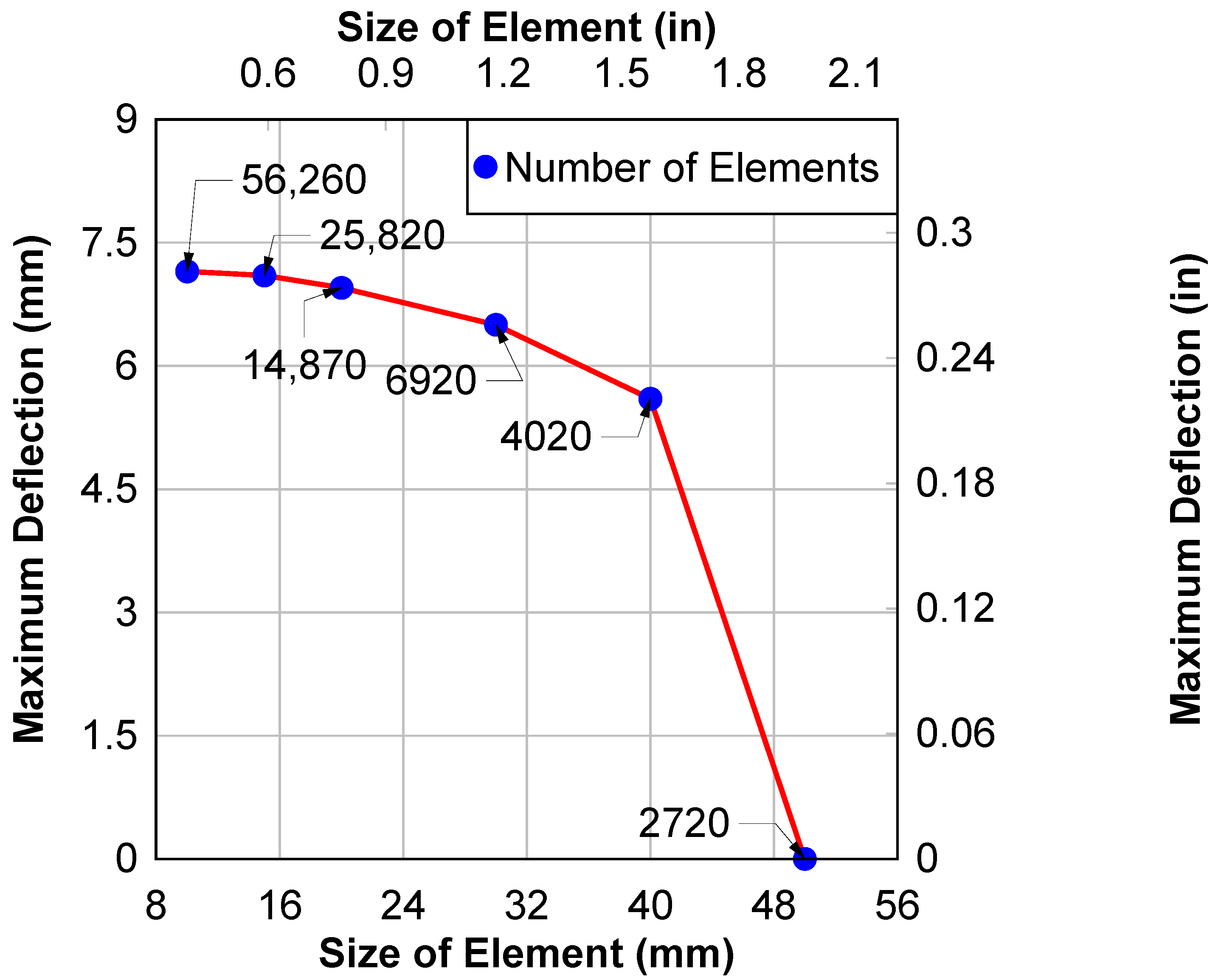



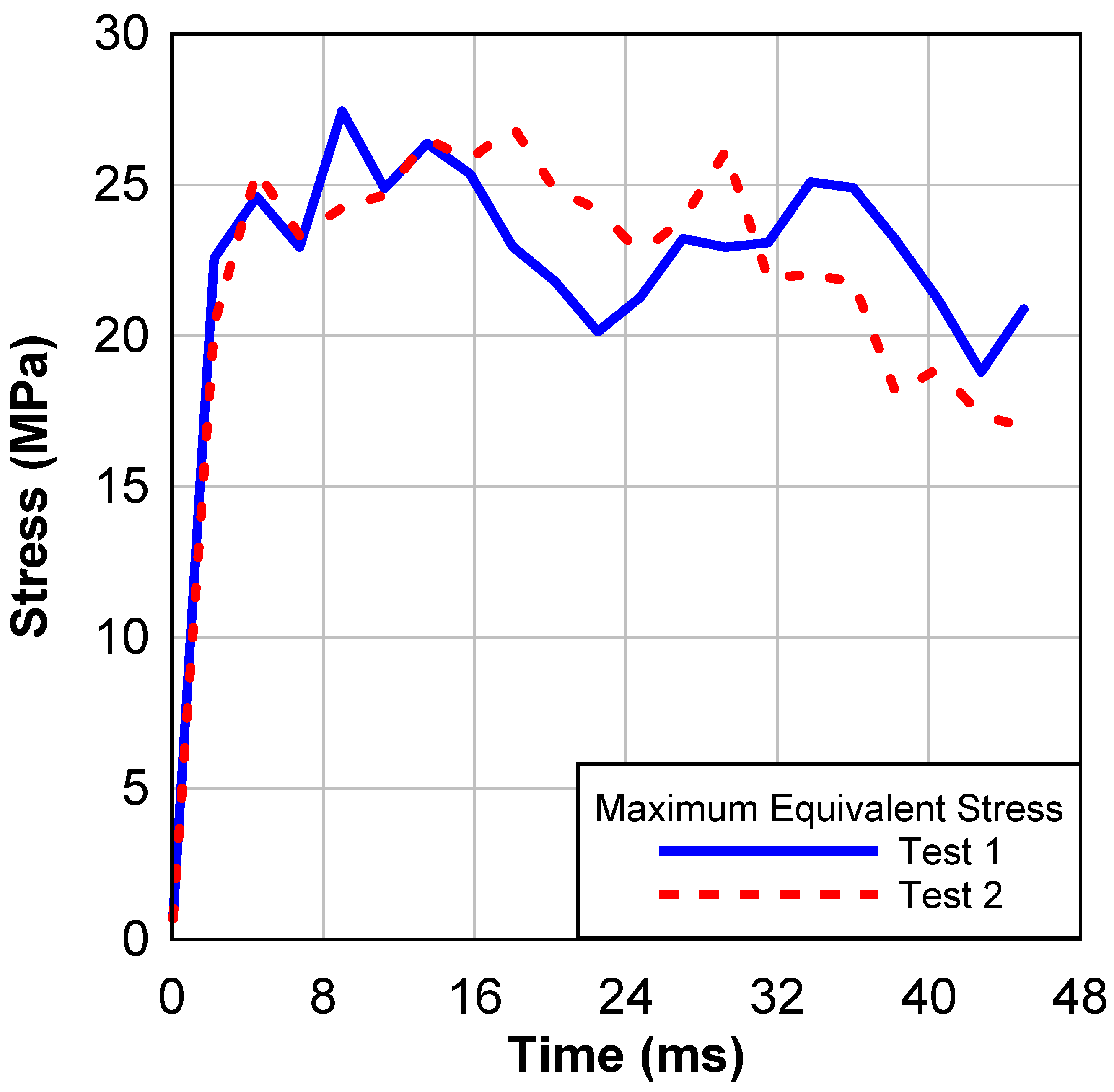
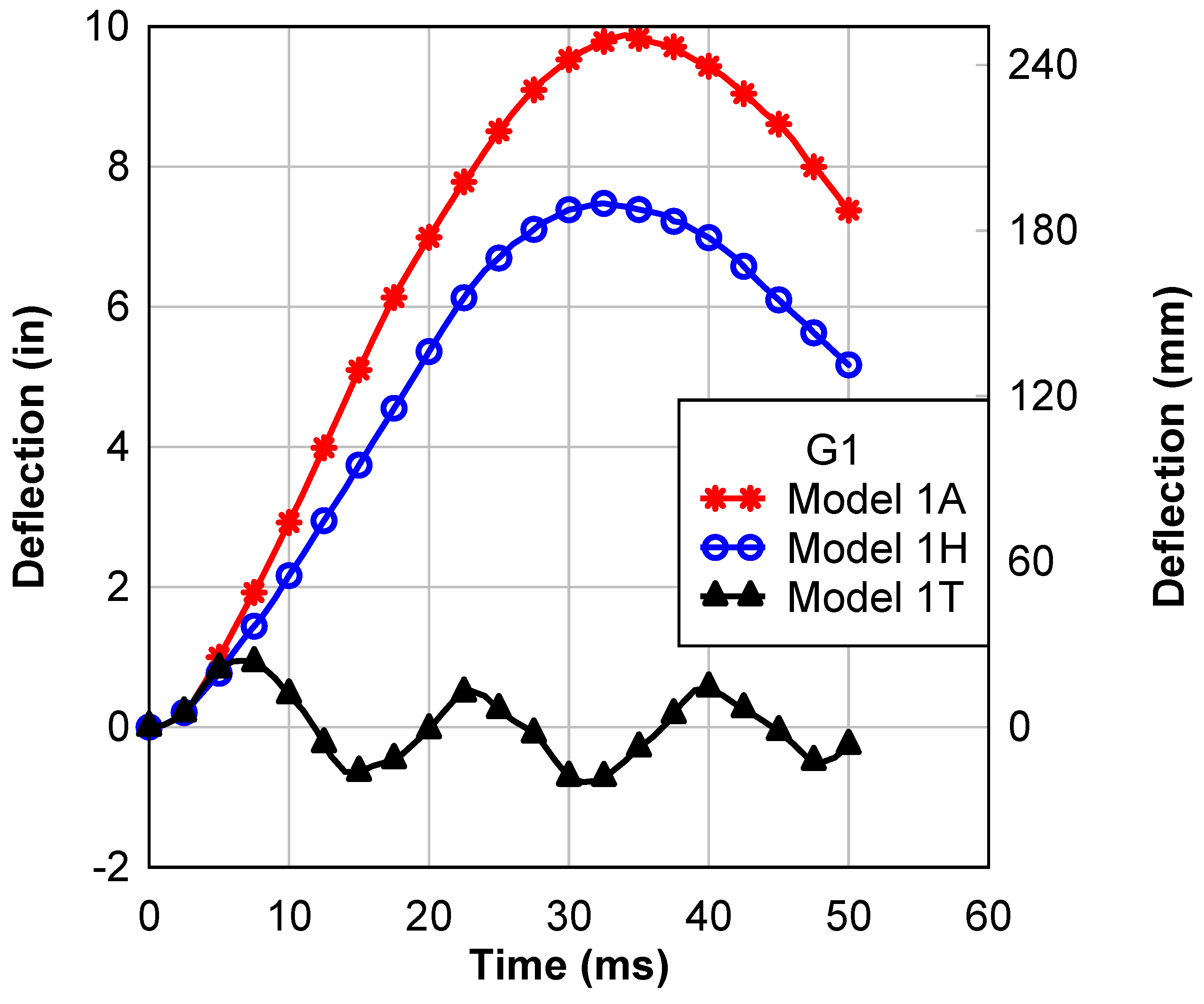
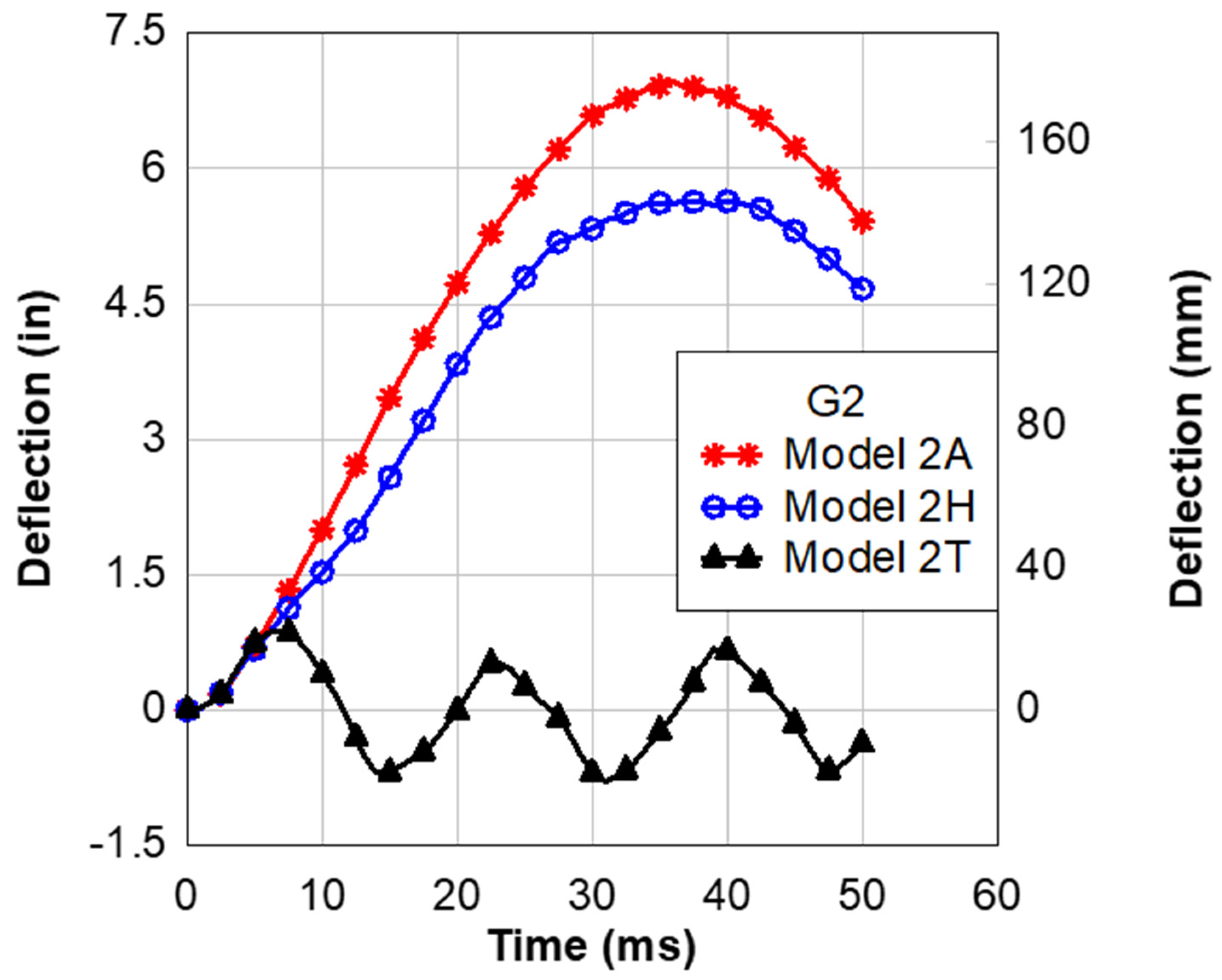

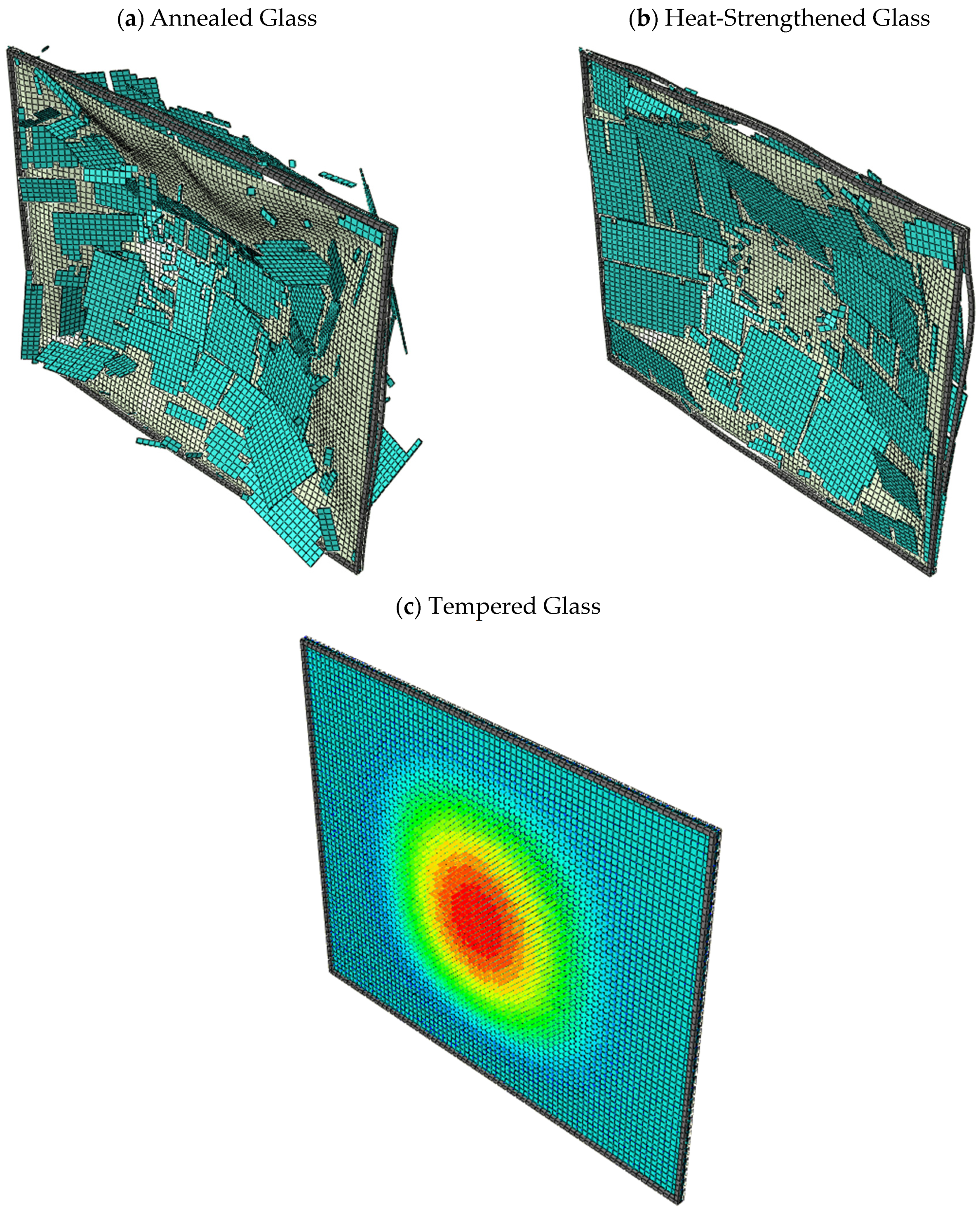
| Group | Average Strain Rate (s−1) | Max. Strain (mm/mm) | Max. Engineering Stress, MPa (psi) | Strain Energy, MPa.mm/mm (psi.mm/mm) | Young’s Modulus, MPa (psi) |
|---|---|---|---|---|---|
| Group 1 | 45 | 1.64 | 26.44 (3835.6) | 28.02 (4064.7) | 149.89 (21,740) |
| Group 2 | 20 | 1.45 | 25.97 (3767.5) | 29.01 (4208.8) | 128.45 (18,630) |
| % Difference | 13.4 | 1.8 | 3.5 | 16.7 |
| JC Parameters | Density (Kg/m3) | Poisson’s Ratio | Young’s Modulus, MPa (psi) | A MPa (psi) | B MPa (psi) | n | C |
|---|---|---|---|---|---|---|---|
| PVB | 950 | 0.45 | 142.43 (20,658.9) | 10.68 (1549.66) | 360.85 (52,338.02) | 4.631 | 0.0741573 |
| Property | Annealed | Heat-Strengthened | Tempered |
|---|---|---|---|
| Density (kg/m3) | 2500 | 2500 | 2500 |
| Young’s modulus (GPa) | 69 | 69 | 69 |
| Poisson’s ratio | 0.23 | 0.23 | 0.23 |
| Max. tensile stress (MPa) | 27.57 | 52.40 | 110.32 |
| Group | Model | Type of Glass | Blast Load | Max. Tensile Stress of Glass (MPa) | |
|---|---|---|---|---|---|
| Pressure | Impulse | ||||
| G1 | Model 1A | Annealed | 26.2 kPa (3.8 psi) | 213.7 kPa-ms (31 psi-ms) | 27.57 |
| Model 1H | Heat-strengthened | 52.40 | |||
| Model 1T | Tempered | 110.32 | |||
| G2 | Model 2A | Annealed | 24.13 kPa (3.5 psi) | 179.3 kPa-ms (26 psi-ms) | 27.57 |
| Model 2H | Heat-strengthened | 52.40 | |||
| Model 2T | Tempered | 110.32 | |||
Disclaimer/Publisher’s Note: The statements, opinions and data contained in all publications are solely those of the individual author(s) and contributor(s) and not of MDPI and/or the editor(s). MDPI and/or the editor(s) disclaim responsibility for any injury to people or property resulting from any ideas, methods, instructions or products referred to in the content. |
© 2023 by the authors. Licensee MDPI, Basel, Switzerland. This article is an open access article distributed under the terms and conditions of the Creative Commons Attribution (CC BY) license (https://creativecommons.org/licenses/by/4.0/).
Share and Cite
Elbelbisi, A.; Elsisi, A.; Saffarini, M.H.; Salim, H.; Chen, Z. Enhanced Blast Response Simulation of LG Panels Using an Elasto-Damage Model with the Finite Element Method. Buildings 2023, 13, 3025. https://doi.org/10.3390/buildings13123025
Elbelbisi A, Elsisi A, Saffarini MH, Salim H, Chen Z. Enhanced Blast Response Simulation of LG Panels Using an Elasto-Damage Model with the Finite Element Method. Buildings. 2023; 13(12):3025. https://doi.org/10.3390/buildings13123025
Chicago/Turabian StyleElbelbisi, Ahmed, Alaa Elsisi, Mohammed H. Saffarini, Hani Salim, and Zhen Chen. 2023. "Enhanced Blast Response Simulation of LG Panels Using an Elasto-Damage Model with the Finite Element Method" Buildings 13, no. 12: 3025. https://doi.org/10.3390/buildings13123025
APA StyleElbelbisi, A., Elsisi, A., Saffarini, M. H., Salim, H., & Chen, Z. (2023). Enhanced Blast Response Simulation of LG Panels Using an Elasto-Damage Model with the Finite Element Method. Buildings, 13(12), 3025. https://doi.org/10.3390/buildings13123025







